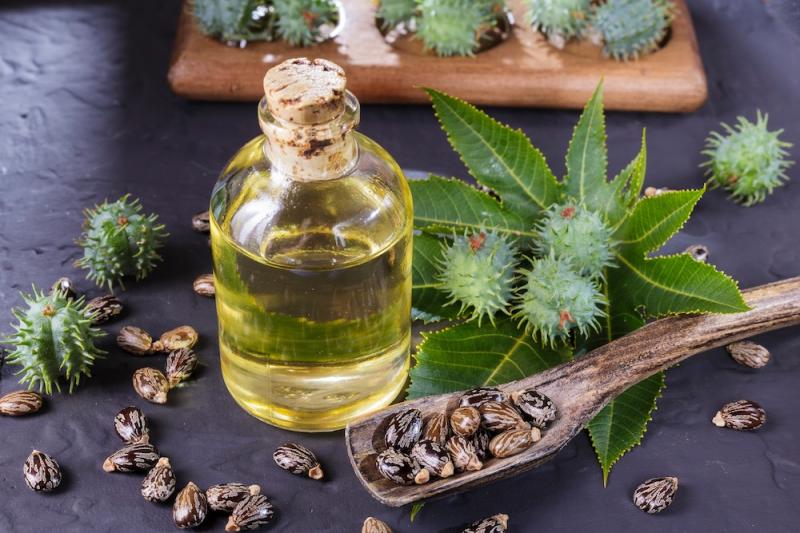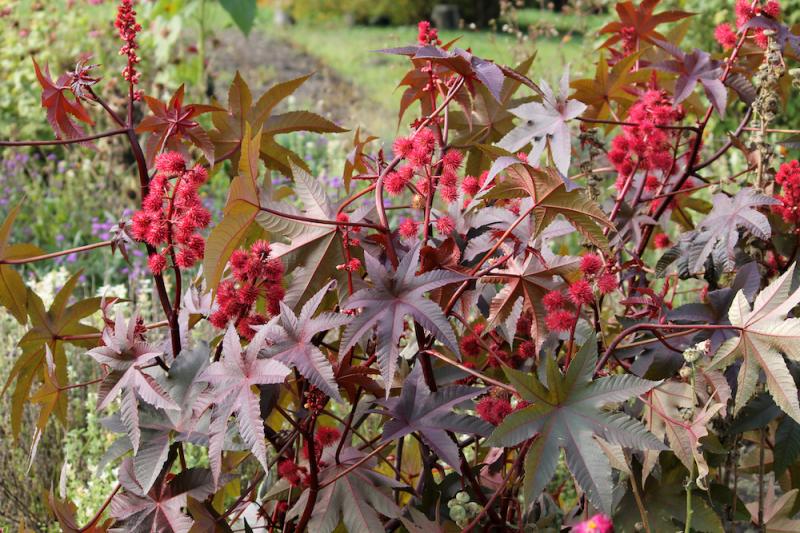
During my life I’ve memorized many poems. One of the poems I memorized when I was still in Elementary school was Eugene Field’s Jest 'Fore Christmas from the 1800's about I rowdy boy who starts to behave right before Christmas so he’ll get good presents. I like how this pair of the lines from the poem illustrates how the use of castor oil as a medicine has been around for a long time:
Castor oil is a strong purgative, which moistens a dry intestinal tract evacuating the bowels. The seeds of the caster bean plant contain a protein called ricin, which is toxic to humans and animals. The oil, which is extracted from the seeds, is heated to eliminate or at least greatly reduce the ricin content, so it loses this toxicity.
Castor oil is approved by the FDA as a laxative. A unique fatty acid, ricinoleic acid, makes up about 90% of its fatty acid content, and is thought to be responsible for its stimulant laxative properties. People don’t use castor oil internally as much as they used to, but many people now use it topically.
Castor oil is moisturizing to the skin and is used in many cosmetics. It has also been found to stimulate the immune system and aid the healing of wounds. It promotes lymphatic drainage and improves circulation, too. You can apply to the oil directly to the skin, but the technique I’m most familiar with is the castor oil pack.
Castor Oil Packs
 Castor oil packs are used topically to break up congestion and help to soften hardened tissue. Specifically, they can be used for any type of lymphatic congestion that is causing swelling and pain, arthritic joints, muscle pain, endometriosis, breaking up cysts or breast lumps, and Peyronie’s Disease.
Castor oil packs are used topically to break up congestion and help to soften hardened tissue. Specifically, they can be used for any type of lymphatic congestion that is causing swelling and pain, arthritic joints, muscle pain, endometriosis, breaking up cysts or breast lumps, and Peyronie’s Disease.
To make a castor oil pack take a soft cloth, such as a cotton wash cloth, and soak it in about ¼ cup of castor oil. Optionally you can add about eight drops of an essential oil to the castor oil. Make sure the cloth is saturated but squeeze it gently so that it isn’t dripping oil.
Fold the cloth and place it in a baking dish and put the dish in the oven at 350 degrees for about 20 minutes. You can also put it in a small crock pot. The cloth should be warm, but not hot. Place folded cloth directly over the area to be treated. Cover it with a dry towel to keep it warm. You can also place a hot water bottle over the pack.
Use the pack once a day for 30 to 60 minutes. After each use, wash the cloth to remove the oil and then rinse and dry it. Also, be sure to wash the crock pot or pan you used.
Castor Bean Leaves
 I had no idea that castor bean leaves were also medicinal until I heard Thomas Easley tell about using them when he was helping out with disaster relief in Haiti. The doctors had run out of medicine and he used castor bean leaf successfully to help one of their patients.
I had no idea that castor bean leaves were also medicinal until I heard Thomas Easley tell about using them when he was helping out with disaster relief in Haiti. The doctors had run out of medicine and he used castor bean leaf successfully to help one of their patients.
The leaves can be used topically as a poultice for many of the same conditions castor oil packs are used. They can reduce swelling and pain, help heal boils and sores, and placed on the abdomen, they can help to ease constipation.
The leaves have also been used internally, and are claimed to have hepatoprotective and emetic effects. However, I have no reliable information on preparations or dosages for internal use of the leaves, so I would advise against using them internally unless it’s an emergency situation like the one Thomas Easley was in.
Castor bean plants are easy to grow. I grew some in my garden in Leeds, Utah and they got very big. I think they’re quite a beautiful plant, too. However, never eat the beans (seeds) as they are extremely toxic. Only used properly treated castor bean oil that has been rendered nontoxic. Even then, I’d use the oil internally only occasionally as it can still have some unwanted side effects. I personally stick with topical use.
Downloads
Steven's Articles
December
-

-
The Evidence for Berberine
A yellow alkaloid found in traditional infection-fighting…
-

-
The Sensible Use of Caffeinated Herbs
Kola nuts, guarana, and yerba mate and other herbs…
-

-
The Health Benefits and Problems with Coffee
This popular caffeinated beverage can be beneficial…
October
-

-
Understanding Caffeine & Cellular Adaptation
Preserving the power of caffeine's buzz and the…
September
-

-
Horseradish
A pungent spice for aiding protein metabolism…
-

-
Banaba or Crepe Myrtle
A beautiful tree from Southeast Asia whose leaves…
August
-

-
Monkeyflowers
Flower essences to help see ourselves more clearly…
-

-
Mariposa Lilies
Strengthening the bond between mother and child…
-

-
The Noble Bay Leaf
A common kitchen herb for aiding digestion and…
-

-
Epimedium: Horny Goat Weed
A circulatory stimulant and kidney yang tonic…
July
-

-
The Medicinal and Nutritional Benefits of Apricots
A nutritious fruit and valuable medicinal seed for coughs
-

-
Dogwoods
Asian dogwood is used to stop excessive discharge,…
June
-

-
Neem: The Village Pharmacy
A popular Ayurvedic remedy for dental and immune…
-

-
Spilanthes: The Toothache Plant
A traditional remedy for teeth and gums, as well…
-

-
Forsythia
An anti-inflammatory, fever-reducing, and infection fighting herb

